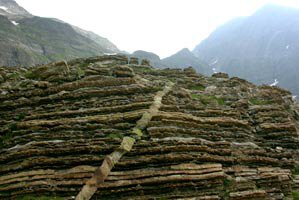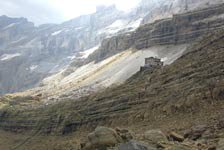Pyrenees Geology
Pyrenees geology

The Pyrenees are a relatively young mountain belt, being part of the Alpine mountain chain, but contain much older rocks than the Alps.
The oldest rocks in the Pyrenees are about 500Ma old, dating from the Hercynian Orogeny (when a huge mountain range covered much of central Europe).
Over the next 200Ma, these ancient mountains were eroded away, and the rocks of the Pyrenees were covered by a shallow sea. Younger, sedimentary rocks were laid down on top.
Around 220Ma ago (probably coinciding with the collision of Africa with Europe), a change in direction of plate movement occurred, leading to closure of the ocean between the Iberian peninsula and what is now the South of France (similar to the gradual shrinking of the Pacific ocean that is occurring today). Eventually, the two continental plates collided, leading to the uplift of the Pyrenees (as is currently taking place in the Himalayas).

Initial mountain-building is thought to have commenced in the Eocene period (30-40Ma), with most uplift and deformation occurring during the Oligocene (20-30Ma). The Pyrenees are a product of collision of the Iberian peninsula with Europe, while the Alps were formed contemporaneously by collision of the Italian peninsula.
Since the Pyrenees are such a young mountain range, numerous thermal springs still persist in the central Pyrenees, and are used locally for their healing properties. Barèges, for example, is the highest and one of the oldest spa villages in the Pyrenees. Today’s Pyrenean landscape is a product of glacial and fluvial action, which has been occurring throughout the Quaternary period (2.58Ma to the present day).

The typical Pyrenean curious U-shaped troughs, waterfalls spewing from hanging valleys, sharp knife-edge arêtes, and majestic, towering cirques (such as the famous Cirque de Gavarnie) are all products of glaciation.
There are a few small glaciers left in the Pyrenees, but these are retreating every year. The largest glacier in the French Pyrenees is the ‘Vignemale’, a bowl-shaped mass of ice sitting stranded above its own moraine, and long U-valley – once filled with ice.
There is a great video made by the Pyrenees National park office about the geological evolution of the Mont Perdu world heritage site available at this link:Geological history of Mont Perdu Video
